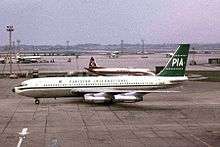Pakistan International Airlines Flight 705
 A Pakistan International Airlines Boeing 720 similar to the one involved in the accident | |
| Accident | |
|---|---|
| Date | 20 May 1965 |
| Summary | Crashed during approach, excessive descent |
| Site | Cairo International Airport, Egypt |
| Aircraft | |
| Aircraft type | Boeing 720B |
| Operator | Pakistan International Airlines |
| Registration | AP-AMH |
| Flight origin | Karachi Airport, Pakistan |
| 2nd stopover | Dhahran International Airport, Saudi Arabia |
| Last stopover | Cairo International Airport, Egypt |
| Destination | London Heathrow Airport, United Kingdom |
| Passengers | 114 |
| Crew | 13 |
| Fatalities | 121 |
| Injuries | 6 |
| Survivors | 6 |
Pakistan International Airlines Flight 705 (PK705) was a Boeing 720 airliner that crashed while descending to land at Cairo International Airport on 20 May 1965. Of the 121 passengers and crew on board, all but 6 were killed.[1] The accident, the fourth and worst involving a Boeing 720, was the deadliest to occur in Egypt at the time and remains the third-deadliest, behind Flash Airlines Flight 604 and Metrojet Flight 9268.
Accident
Flight 705 on 20 May 1965 was an inaugural flight between Karachi, Pakistan and London, United Kingdom and was carrying distinguished guests and journalists among the 114 passengers.[2] The aircraft was planned to stop at Dharan in Saudi Arabia, Cairo and then Geneva before completing its journey to London.[2][2] As the aircraft was on final approach to Cairo International Airport, the pilot reported problems with the flaps; shortly thereafter, the aircraft crashed southeast of the airport and broke up as it exploded into flames.[2] Six of the passengers were thrown clear of the wreckage, but everyone else on board was killed.[2]

Aircraft
The aircraft was a Boeing 720-040B[note 1] with the registration AP-AMH and manufacturer's serial number 18379; it was first flown on 19 October 1962 and delivered to Pakistan International Airlines on 7 November 1962.[3] At the time of the accident the aircraft had flown 8378 hours.[3]
Aftermath
On 26 May the local police reported that a transistor radio had been found in the wreckage of the aircraft with jewellery valued at $120,000 hidden in it.[4]
Investigation
The probable cause was that "The aircraft did not maintain the adequate height for the circuit and continued to descend until it contacted the ground. The reason for that abnormal continuation of descent is unknown".[5]
See also
Notes
References
- ↑ Accident description at the Aviation Safety Network
- 1 2 3 4 5 "121 Killed in Desert Air Disaster – Pakistan Plane Crashed on new London Route". News. The Times (56327). London. 20 May 1965. p. 14.
- 1 2 Pither 1998, p. 213
- ↑ "£43,000 Jewels in Airliner Wreck". News. The Times (56332). London. 27 May 1965. p. 11.
- ↑ ICAO Circular 88-AN/74 (113–117)
- Pither, Tony (1998). The Boeing 707 720 and C-135. England: Air-Britain (Historians) Ltd. ISBN 0 85130 236 X.
External links
Coordinates: 30°07′19″N 31°24′20″E / 30.12194°N 31.40556°E
.jpg)